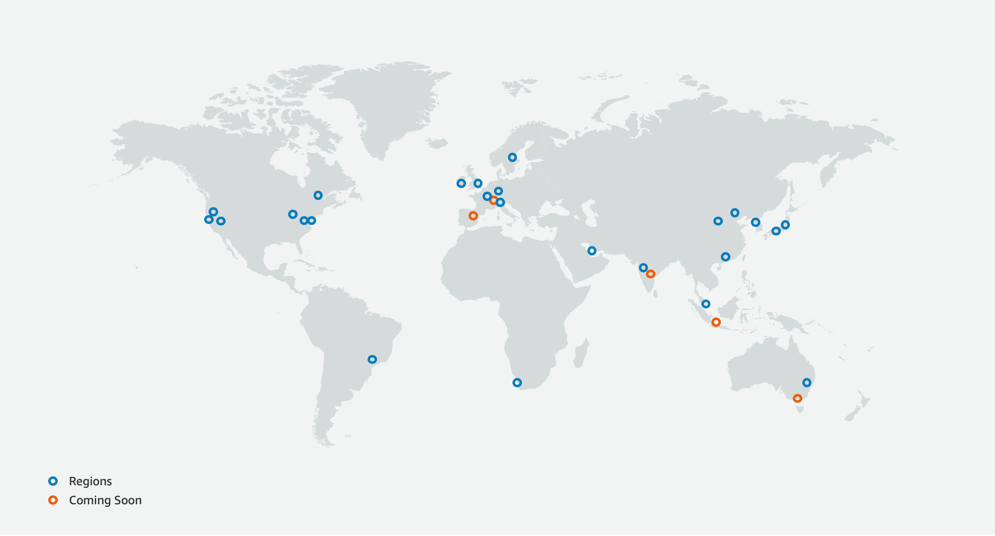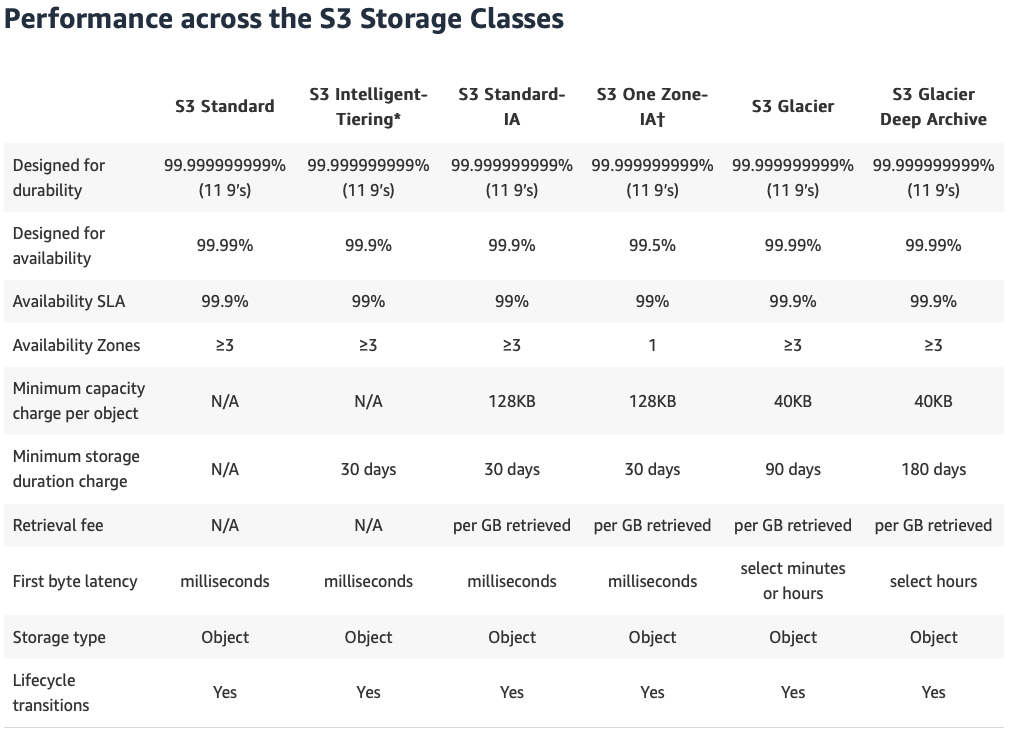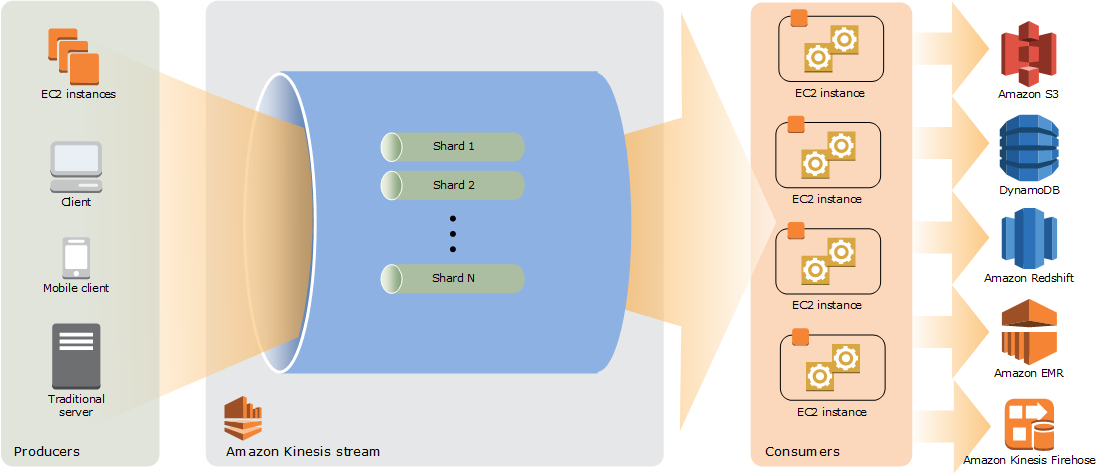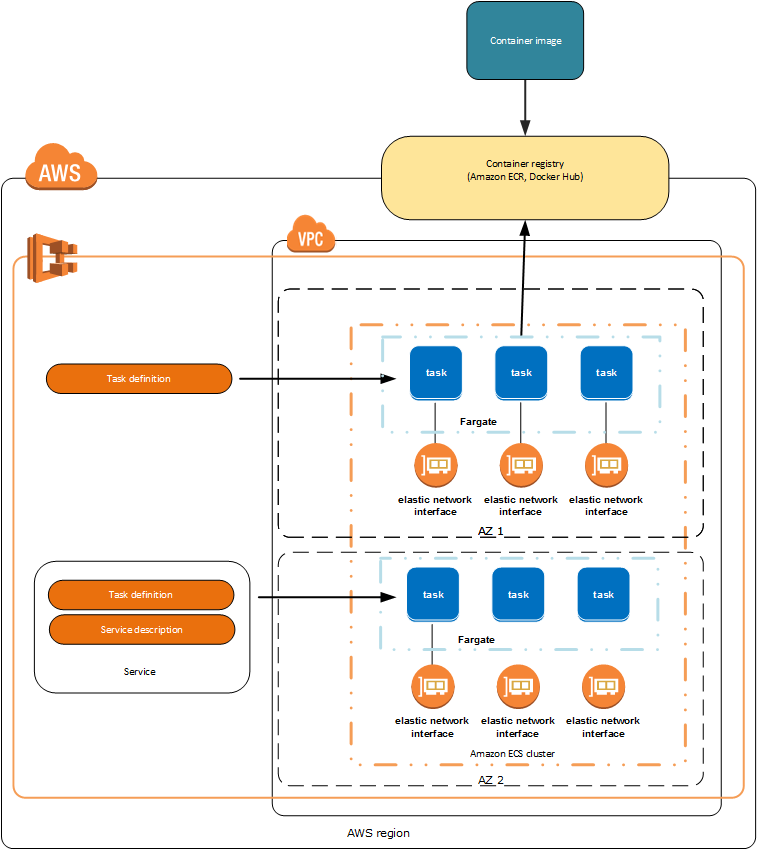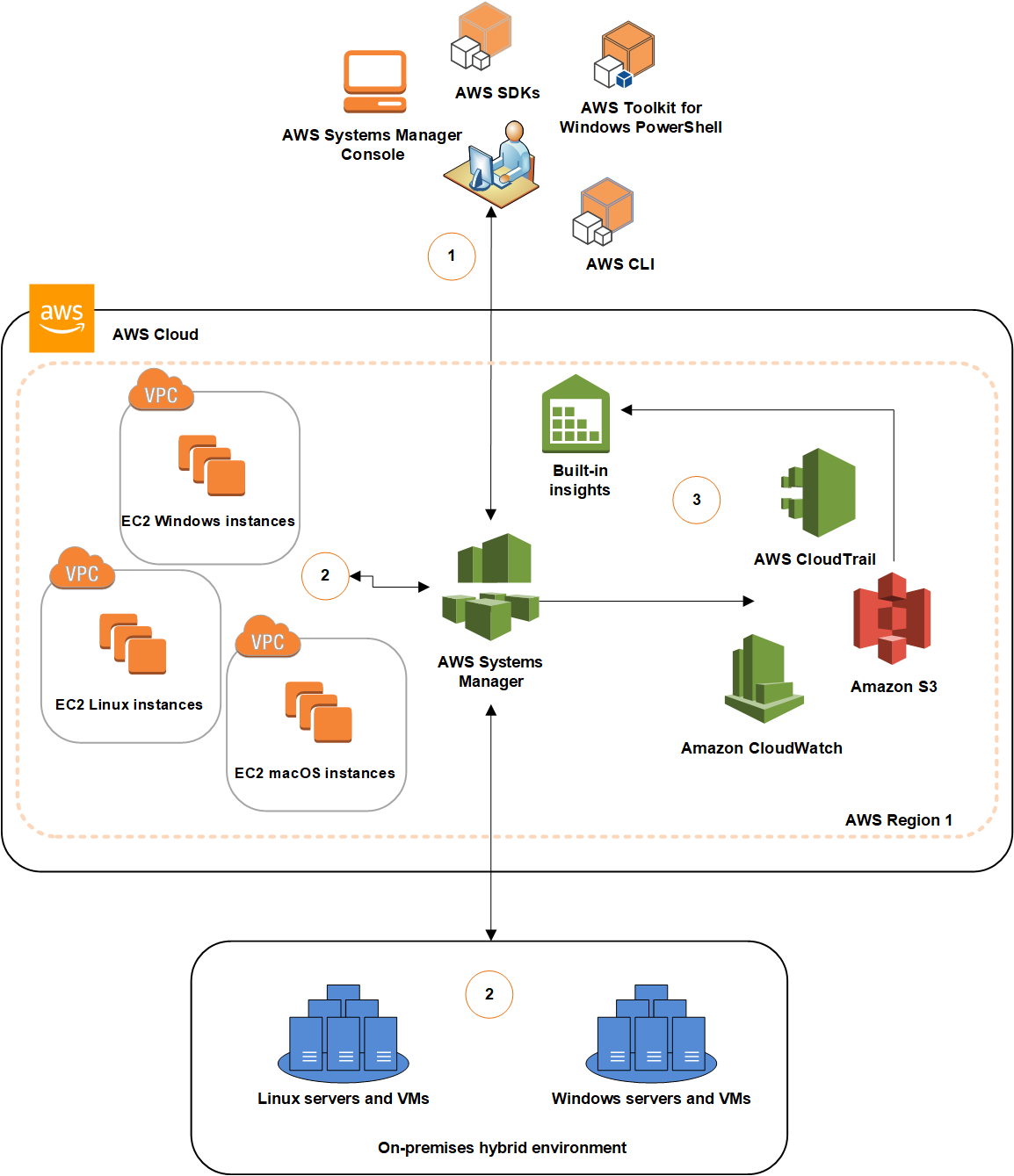All icons and images are owned by AWS.
- Describe who is the audience of this document
- Sort services
- Introduction
- Regions
- S3
- SQS
- SNS
- Kinesis
- RDS
- 🚧 DynamoDB
- EC2
- ASG
- ECS
- VPC
- Parameter Store
- ElastiCache
- Route 53
- ELB
- Lambda
- CloudFront
- IAM
- 🚧 WAF
- ARN
- Certification
- Links
- Dominant cloud computing provider
- Founded 2002, first cloud service (S3) in 2006
- Annual revenue in 2020: $46 billion
- Fun fact:
Amazon annual revenue 2020: $280 billion, EBIT $23 billion (including AWS)
AWS EBIT was $13.5 billion (that is 58%❗️)
source: Amazon report 2020, p25 and p26
- Fun fact:
- AWS owns around ~32% off the cloud market, its competitors are Microsoft Azure (18%) and Google Cloud (9%)
EMEA (Europe Middle East Africa):
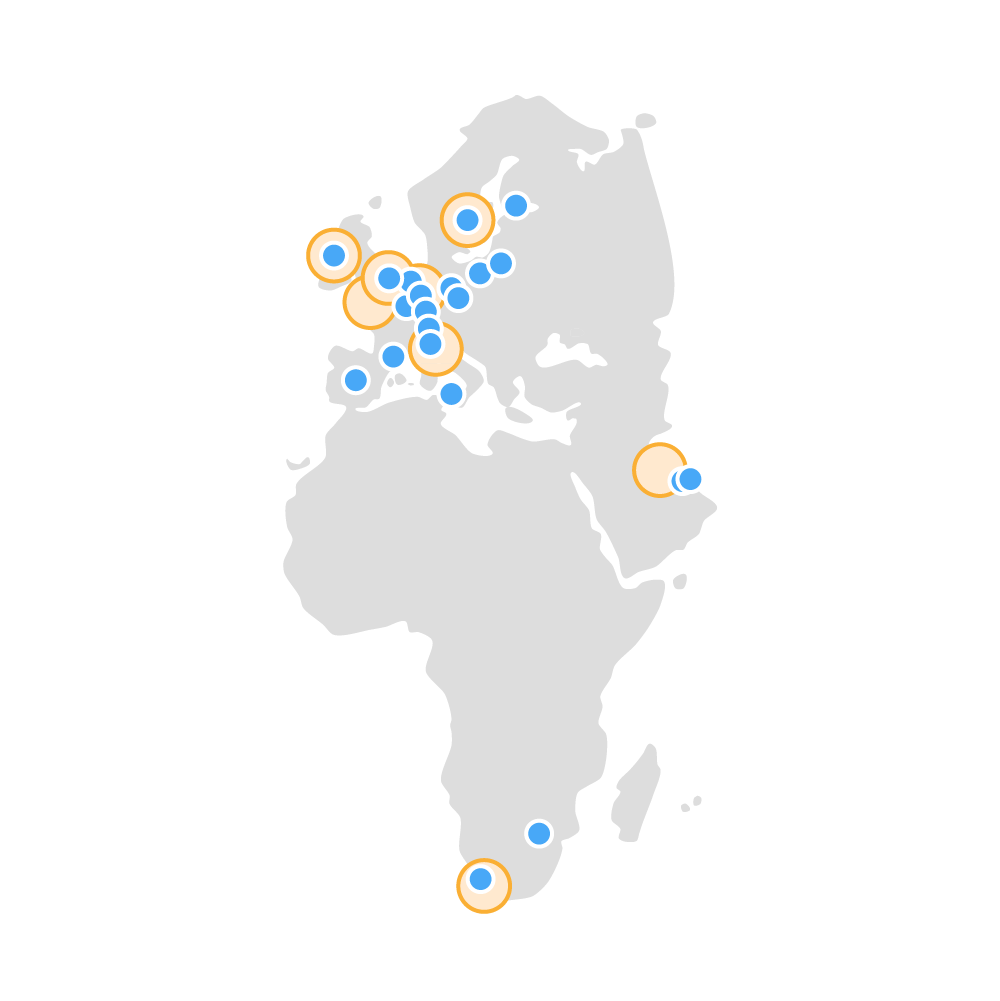
-
Global Infrastructure
-
Region = Location
-
Region consists of multiple
AZs(Availability Zones) -
Near us (Germany):
Code Name / City Country Since eu-central-1Frankfurt 🇩🇪 Germany 2014 eu-west-1Ireland 🇮🇪 Ireland 2007 eu-west-2London 🇬🇧 UK 2016 eu-west-3Paris 🇫🇷 France 2017 eu-south-1Milan 🇮🇹 Italy 2020 eu-north-1Stockholm 🇸🇪 Sweden 2018 eu-east-1? 🇪🇸 Spain Upcoming (2022/2023) -
AZs are physically separated from each other
- Connected via low latency links
- Marked by a letter behind region code
- eg.:
eu-central-1[a,b,c] - Warning:
eu-central-1ais not an unique identifier (depends on the account) read more
- eg.:
- Traffic within one
AZis free (rule of thumb)
- Cloud block storage
- Arbitrary number of files, each up to 5TB per file
99.999999999%(11 9s) durability (= 10 million objects saved over 10,000 years -> expectation: 1 is lost)99.9%availability SLA (but designed for99.99%) inStandard- Different storage classes
Standard- Low latency and high throughputIntelligent Tiering- Automatically optimizes storage costs (depending on access pattern)
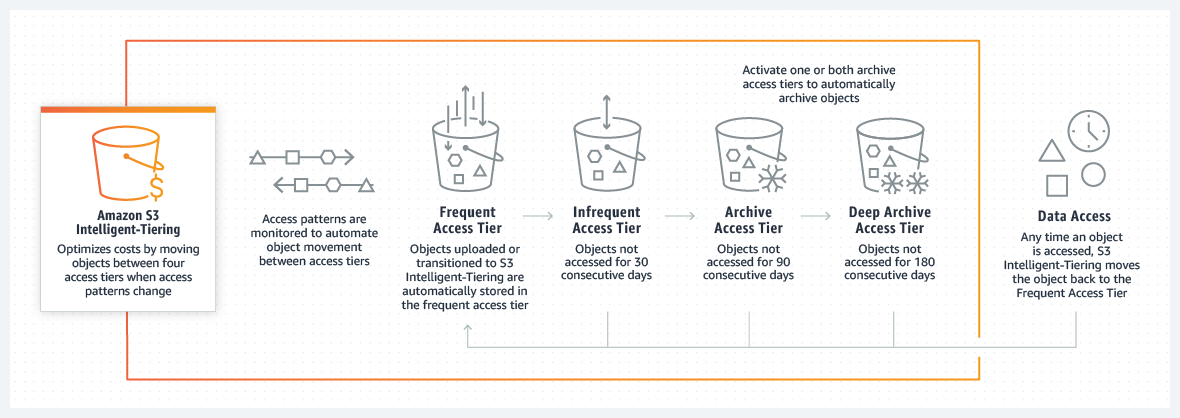
Standard-IA(IA = Infrequent-Access) - Same as Standard but less availabilityOne Zone-IA- Only one AZ -> less availabilityGlacier- Very cheap; retrieval time at least a few minutesGlacier Deep Archive- cheapest option, at least 12 hours retrieval time- Dictates the price
- Standard =
$0.0245/GB - Glacier Deep Archive =
$0.0018/GB(92,65% less)
- Standard =
- S3 only knows of keys, eg. when you store
path/to/a/filethis (=path/to/a/file) is also the key, but the S3 management UI showspath,toandaas a directory - Versioning, Encryption, Lifecycle Management, Events
- Decouples systems, messages have to be pulled
- Two types
Standard: 3,000 messages / sec, at least once (occasionally more than one time), best effort orderingFiFo: 300 messages / sec, exactly once, first in first out
- Visibility timeout while processing (after message pull) (max. 12 hours)
- Batching of messages possible, max payload
256KB - Max. message retention 14 days
DLQ(Dead Letter Queue): unprocessable messages are automatically moved
- Pub / Sub (Topics)
- Standard, FiFo
- Filtering, Fanout
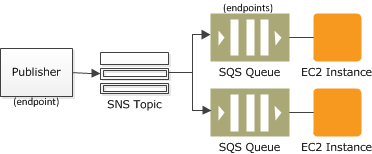
- Push to
- Lambda
- SQS
- Kinesis
- HTTP
- SMS
- In comparison to SQS this is push (whereas SQS is pull)
- Kinesis Video Streams, Kinesis Data Streams, Kinesis Data Firehose, Kinesis Data Analytics
- Real time (within 70ms)
- Multiple producer, multiple consumer
- Shard is base throughput unit (
1MB/swrite,2MB/sread) - Every event has a partition key (is used for routing onto a shard; usually user ID)
- Different engines available
- MySQL
- MariaDB
- Oracle
- Microsoft SQL Server
- PostgreSQL
- Aurora
- MySQL or PostgreSQL compatible (it's a fork)
- Serverless (‘can sleep’), automatic scaling
- Read replicas (performance)
- Multi-AZ deployments (availability, durability)
- Automated backups, snapshots
- Maintenance window (applying backups and stuff, downtime possible)
🚧 TODO
- Many
AMI(Amazon Machine Image) available - Different Instance types
- General Purposes
- Compute Optimized
- Memory Optimized
- Accelerated Computing (GPU)
- Storage Optimized
- Nice EC2 instance type overview (former ec2instances.info)
- Max is
U-24TB1 Metal:448vCPU,24576GBRAM
- Storage options
- Instance Storage - fastest
EBS(Elastic Block Storage) - can only be attached to one instanceEFS(Elastic File System) - can be shared by multiple instances
- Hibernation - write RAM into EBS and start from that again

- Spot Instances - spare capacity, can be terminated within 2 minute notice (save up to 90% off On-Demand price)
- Saving Plans - commitment on a certain $/hour usage for 1 or 3 years (all, partial or no upfront payment) (save up to 72%)
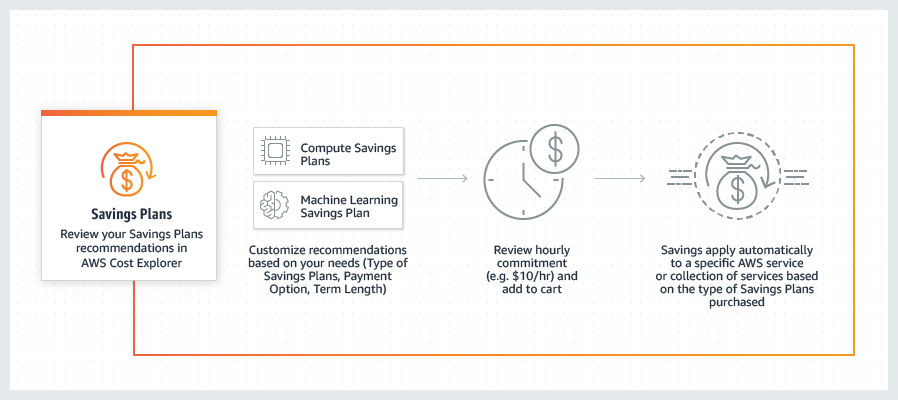
- Reserved Instances - commitment on a certain instance type or family (save up to 72%)
- Minimum, desired and maximum capacity
- Will ensure the desired capacity at all time
- Three different scaling strategies: manual, dynamic, scheduled
- Manual scheduling
- Keep desired capacity all the time
- Dynamic scheduling
- Target tracking scaling: maintain a certain value of a metric (and increase or decrease desired capacity based on that metric)
- Step scaling: increase or decrease desired capacity based on a set of scaling adjustments
- Simple scaling: increase or decreased desired capacity on a single scaling adjustment
Example of scaling based on a custom metric in connection with SQS:
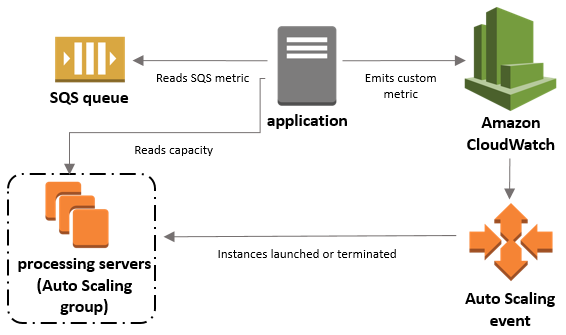
- Can run on
EC2orFargate(serverless) ECSconsists of clusters- Deployment ensures availability (you can set a minimum of healthy tasks in percent)
- Failed tasks are automatically replaced

Can be used to store and provide Docker Images
Managed Kubernetes Service
- Every VPC has its own IP address space
Subneta segment of a VPC IP address space- Instances in a private subnet do not have a public IP address
- Instances in a public subnet do have a public IP address
Internet Gatewayaccess to the public Internet (and access from the Internet)NAT Gatewayaccess to the internet from private subnets (NAT = Network Address Translation)Virtual private gatewayendpoint for a VPN connectionPeering Connectionallows communication between two peered VPCs (not transitive)VPC Endpointprivate connection to other servicesEgress-only Internet Gatewayegress only access for IPv6 traffic (like NAT for IPv4)
Example of a VPC with an Internet Gateway:
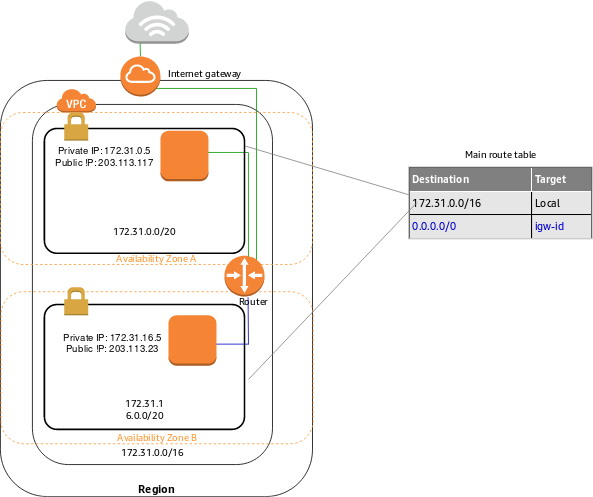
VPN connection between AWS and a corporate network is possible:
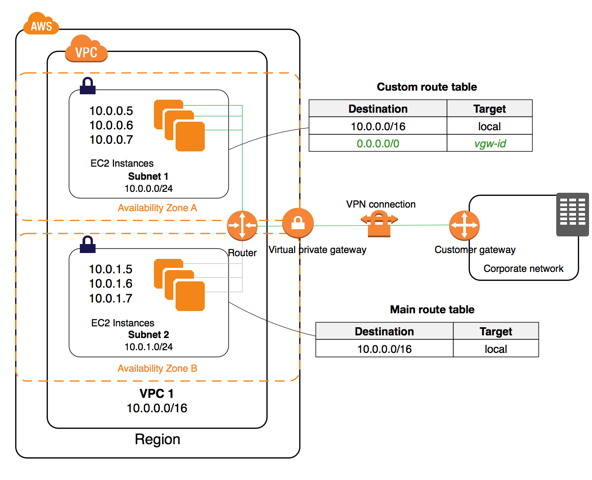
PrivateLink can be used to access another AWS service without using public internet: (PrivateLink uses VPC Endpoint)
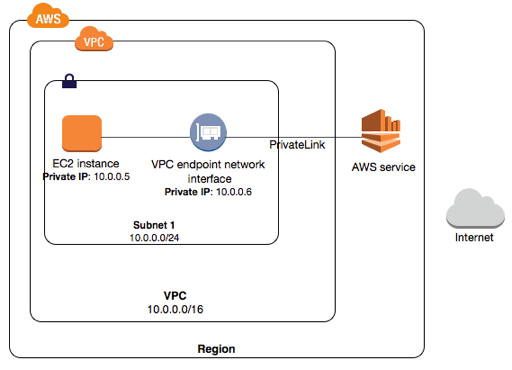
Flow within a network, passing through SG, NACL, ...
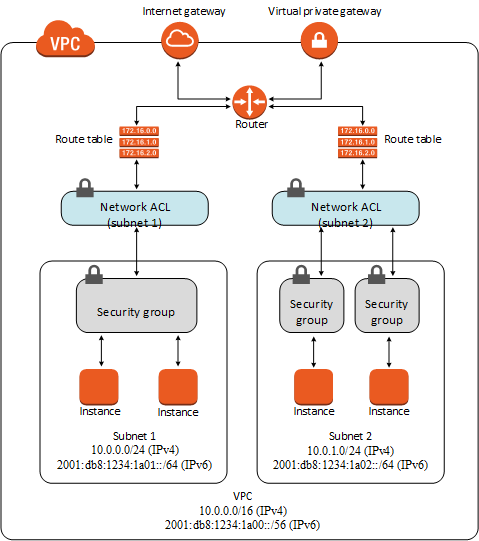
- ALl traffic is denied by default (unless allowed by a rule)
- A rule can only allow traffic and not deny it
SGsare stateful- When a rule allows outgoing traffic, the response is allowed too regardless of the incoming rules
- When a rule allows incoming traffic, the response is allowed too regardless of the outgoing rules
- Instances within the same security group can't communicate with each other (unless allowed by a rule)
- A source for a rule can be:
- a security group
- IPv4 CIDR block or a single IPv4
- IPv6 CIDR block or a single IPv6
- or a prefix list ID
- You can specify the protocol (TCP, UDP, IDMP), and a port range for a rule
- A rule can (in contrast to a SG) deny traffic
- A rule has a number
- Evaluation of rules start with the lowest number
- Evaluation stops as soon as a rule matches traffic
- Key Value store
- Typically used for storing passwords, configuration etc.
- Datatypes:
String,StringList,SecureString SecureStringuses KMS (Key Management Service) to encrypt value- Can be automatically retrieved by EC2, ECS, Lambda, ...
- Redis or Memcached
- Maintenance window for applying patches
- Parameter group to define engine configuration values
- Cluster, Read Replica, Multi-AZ
- DNS Service
- Different routing policies
Simple: standard DNSWeighted: portion of traffic to each resourceGeolocation: depending on locationLatency: depending on latencyFailover: when health check fails, failover to nextMultivalue: chooses randomly one value
- Private DNS within VPC
- Alias records as own feature (like CNAME)
- Different types
ALB(Application Load Balancer)- Layer 7 (Application)
- HTTP, HTTPS, gRPC
- Target types: IP, Instance, Lambda
- Header based routing, redirect
- "Standard"
NLB(Network Load Balancer)- Layer 4 (Transport)
- TCP, UDP, TLS
- Target types: IP, Instance
- Used for extreme performance / low latency
GWLB(Gateway Load Balancer)- Layer 3 (Network)
- IP
CLB(Classic Load Balancer)- old, shouldn't be used for new projects
- previously known as ELB (before introduction of ALB)
- Health checks for targets
- Runs code without provisioning or managing servers, pay only for the time your code runs
- Supports different languages (
Java,Go,PowerShell,Node.js,C#,Python, andRuby) - Can be triggered by different services (e.g. ELB, S3 Event, ...)
- Maximal runtime is 15 minutes
- Define the needed memory (between 128 MB and 10,240 MB) - the compute power is scaled accordingly (1,769 MB = 1 vCPU)
- (Beware cold starts) improved significantly
- Failed events can be sent into a
DLQ(Dead Letter Queue)
CDN(Content Delivery Network)- Improves latency by hosting at different PoPs (Point of Presence) (AWS name: Edge Location)
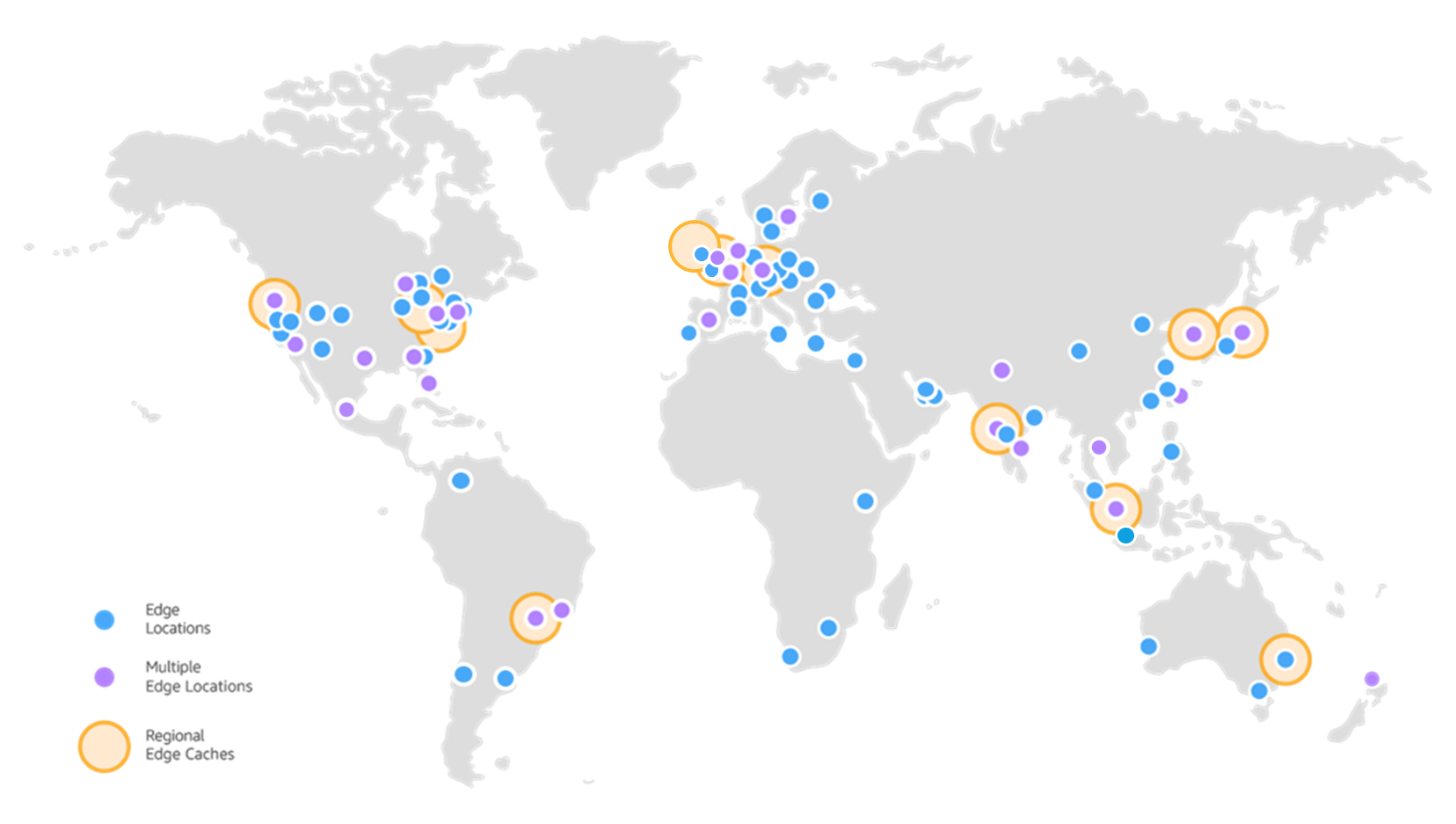
- Can work with S3, EC2, ELB or any HTTP origin
- Therefore, it can serve static and dynamic content
- Routing can be customized with
Behavior
Example of CloudFront serving a file from S3 as origin:
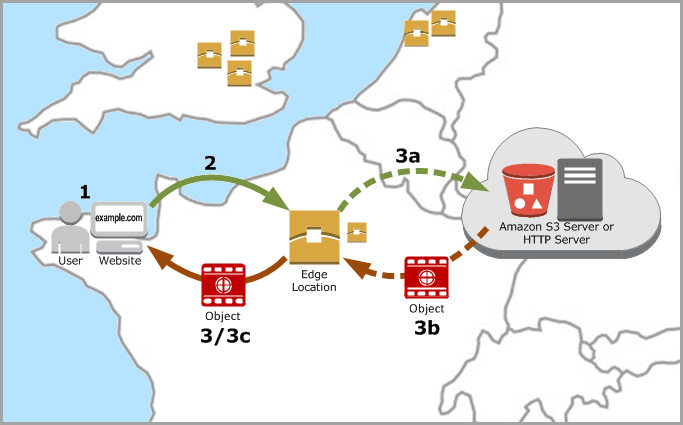
Example of dynamic and static serving with CloudFront:
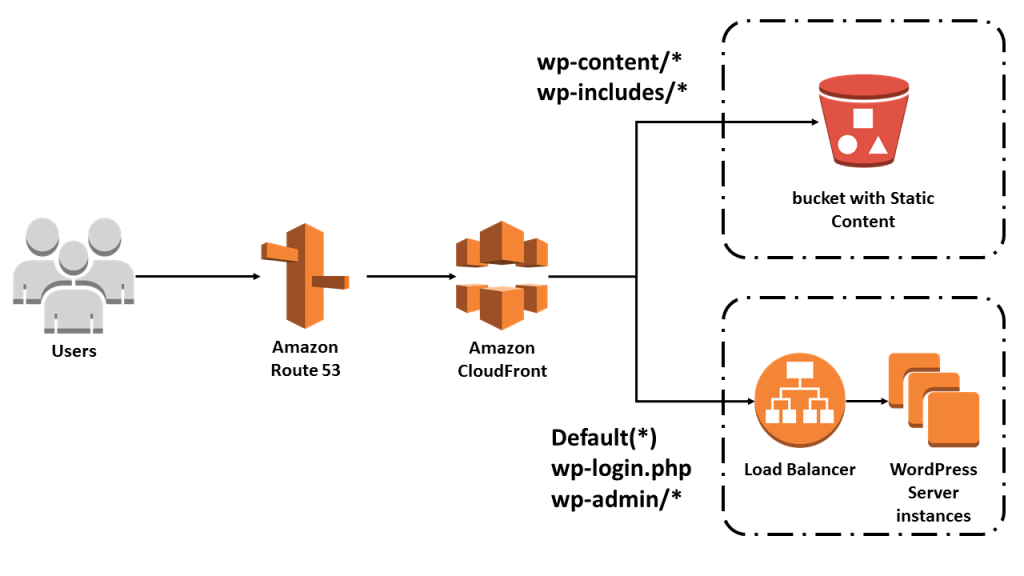
- Users, groups and roles
- Users = people or services (can have credentials)
- Groups = container for users (can belong to another group)
- Roles = services
- Policies are permissions to do something
- can be attached to users, groups and roles
- Use Policy Simulator to check and validate effects of policies
- Roles can be assumed
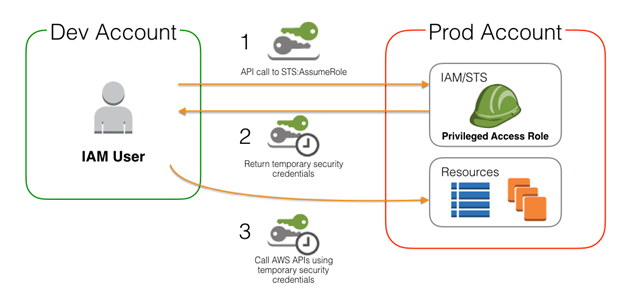
- Federation of users with some kind of directory possible
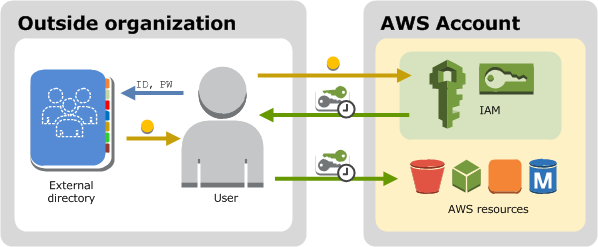
- Permissions hierarchy:
- Explicit deny
- Explicit allow
- Implicit deny
Example Policy:
{
"Version": "2012-10-17",
"Id": "some-unique-id",
"Statement": {
"Sid": "1",
"Effect": "Allow",
"Principal": { "AWS": "arn:aws:iam::123456789012:user/dirk" },
"Action": [
"s3:PutObject",
"s3:Get*"
],
"Resource": "arn:aws:s3:::my-bucket/*",
"Condition": {
"DateGreaterThan": {
"aws:CurrentTime": "2021-12-02T13:37:42Z"
}
}
}
}Version- defines language syntax (two valid values2012-10-17,2008-10-17)Id- identifier for policy, used by different servicesSid- short forstatement ID, identifier for statementEffect- does this statement allow or deny something? (two valid valuesAllow,Deny)Principal- specifies a principal that is allowed or denied access to a resource (when not attached to a user, group or role)- whole AWS account:
"Principal": { "AWS": "arn:aws:iam::123456789012:root" } - a specific user:
"Principal": { "AWS": "arn:aws:iam::AWS-account-ID:user/user-name" } - an IAM role:
"Principal": { "AWS": "arn:aws:iam::AWS-account-ID:role/role-name" } - an assumed-role:
"Principal": { "AWS": "arn:aws:sts::AWS-account-ID:assumed-role/role-name/role-session-name" } - an AWS service:
"Principal": { "Service" : [ "ecs.amazonaws.com" ] } - every one:
"Principal": "*" - there are options for federated web identities and users
- whole AWS account:
Action- which actions are allowed or denied (e.g.sqs:SendMessage,s3:PutObject)Resource- to which resources this policy appliesCondition- additional conditions which must be true for the policy to be applied- there are also
NotPrincipal,NotActionandNotResourcebut be cautious with them
🚧 TODO
General formats:
arn:partition:service:region:account-id:resource-id
arn:partition:service:region:account-id:resource-type/resource-id
arn:partition:service:region:account-id:resource-type:resource-id
partitioneither:aws'Standard'aws-cnChina Regionsaws-us-govGovCloud Regions
servicean AWS service (e.g.s3)regionthe region (e.g.eu-central-1)account-idID of the AWS accountresource-idID of the resource
Mind that the specific ARN depends on the resource!
For example Cloud Practitioner:
- 65 questions in English (or Indonesian, Japanese, Korean or Simplified Chinese)
- 90 minutes
- Price $100
Recommendation: Udemy course from Stephane Maarek is a good starting point
